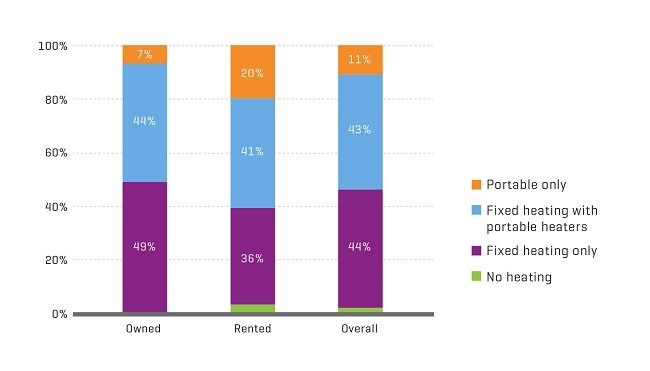The choice or availability of different heating appliances in the home has implications for both the effectiveness and cost of ensuring a warm, comfortable, healthy environment.
Heat pumps, enclosed wood burners and flued gas heaters are among the more effective and cost-effective appliances although correct sizing and fitting are essential. For more information on different heating choices, see the EECA Energywise website.
The survey found that more owner-occupied homes (93%) had fixed heating appliances (heat pumps, wood burners and flued gas heaters) than rental homes (77%). One-fifth of rental properties had no fixed heating system and were reliant on portable heating only, almost three times the proportion of owner-occupied homes. Portable heaters can be more expensive to operate and less effective for heating larger living spaces than fixed heating appliances.

Winter heating habits
A householder appliance use questionnaire commissioned by EECA was a new addition to the 2015 House Condition Survey. It asked when householders usually heated living areas and occupied bedrooms in winter and the type of heater used most in each room.
The results showed that, in 46% of households, no occupied bedrooms were usually heated in winter, even in bedrooms occupied by children or older adults.
Without any heat input in winter, it is unlikely the indoor temperature would always achieve the World Health Organization [PDF, 1,160KB] minimum recommended level of 18°C (or higher for rooms occupied by potentially vulnerable groups such as young children, older adults or those with illness).
The appliance use survey also reinforced the difference between owner-occupiers' and tenants' use of different heating appliances. Owner-occupiers were more likely to use heat pumps and wood burners to heat the main living area, while tenants most commonly used electric heaters.
Unflued gas heaters (fixed or portable) were present in over one-fifth (21%) of rental houses surveyed, and portable unflued gas heaters were being used to the heat the living area in 15% of rental properties. Unflued gas heaters release harmful emissions and water vapour into the home. If the area is not ventilated properly, this can severely reduce indoor environmental quality, increase the risk of damp and mould and impact on the health of occupants. Use of unflued gas heaters in bedrooms goes against Ministry of Health advice. They are also one of the most expensive forms of space heating in the home.
